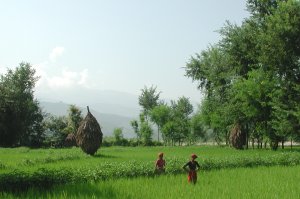
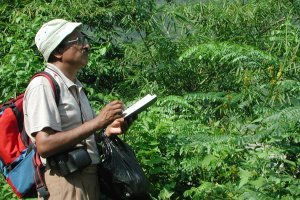
Forest vegetation and prominent tree species in the Arun Valley and Langtang National Park encountered during the ENEP expedition
Arun Valley
M.N. Subedi
We flew from Kathmandu to Biratnagar (100m a.s.l.) and up to Hile by bus through mountain terrain. We started plant collection at Hile (1850m), a hill-station and a small local town of eastern Nepal. We descended from Hile to Mangmaya Khola (330m), a small tributary of the big Arun River. The upper parts of the valley slopes have sparse human settlement and most of the area is under cultivation and the prominent natural vegetation consists of thin patches of forest of Alnus nepalensis. The lower parts consist of widely distributed but largely modified Shorea robusta forest and mixed Pinus roxburghii forest of moderate stature. Frequently observed tree species were Lagestroemia parviflora, Mallotus philippensis, Terminalia spp., Emblica officinalis, Plumeria rubra, Sapium insigne, Schima wallichii, etc. Ficus benghalensis and F. religiosa were found at resting platforms along the footpath with very wide shady canopy.
From Mangmaya we travelled along the east bank of Arun river for about two days. The vegetation along this valley is highly disturbed due to the local people and forest patches of primary origin are seen only on the steeper slopes. Prominent tree species that form a major part of the vegetation were Acacia catechu and Adina cordifolia. Other frequently observed tree species were Semecarpus anacardium, Syzyzium spp., Aegle marmelos, Duabanga grandiflora, Bombax ceiba, etc. Associated shrubs and woody plant species included Holarhena pubescens, Cipadessa baccifera, Randia spinosa, Flemingia strobiliflora, etc.


From Tumlingtar (450m) we again ascended slowly passing through Shorea robusta forest. Most of the trees were young and in growing condition but some trees of 1m or more in diameter along with the presence of several cut stumps show that this region had mature Shorea forest in the past. Above the forested area the hill slopes were again found to be inhabited by many human settlements and local towns with sparsely distributed trees and disturbed vegetation intermixed with agricultural fields that extend up to Bhotebas (1750m). Prominent trees of this area included Bauhinia purpurea, Macaranga pustulata, Alangium sp., Maesa chisia, Saurauia napaulensis., Prunus cerasoides, Fraxinus floribunda, Brassaiopsis sp., etc. Small patches of Schima - Castanopsis were met frequently. After Bhotebas we entered into a more densely forested area but in this vicinity (within an area of a few km) there are clear signs of human encroachment shown by the large number of trees in early growth condition and heavy disturbance. After Kuwapani (1870m) a big forest of Castanopsis tribuloides was entered that extends up to Chichila (1860m). The forest associates are Prunus cornuta, Euraya cerasifolia, Cinnamomum tamala, Symplocos ramosissima, Lithocarpus sp., Maesa chisia, Viburnum erubescens, etc. We returned back to Kathmandu from Chichila by the same route via Tumlingtar (450m).
Langtang National Park
The next part of the botanical expedition was conducted in Langtang National Park. We proceeded by bus from Kathmandu up to Dhunche (2000m), district capital of Rasuwa as well as National Park Headquarters. We started collecting plants here. A regenerating Alnus nepalensis forest patch (1900m) was observed after Dhunche along the streamside. We ascended slowly towards Gosainkunda, a famous and sacred high altitude lake. At lower elevation (2000m) the major forest components found were Pinus wallichiana, Dodecadenia grandiflora and an arborescent Labiatae - Leucosceptrum canum. A forest of prickly leafed oak, Quercus semecarpifolia, mixed with Rhododendron arboreum, appeared from 2500m and Tsuga dumosa after 2700m which are also intermixed with Pinus wallichiana and Rhododendron arboreum still dominant up to 3000m. Abies spectabilis forest started from 3000m and the canopy height of these trees attained up to 40m around Sing Gompa (3220m). Here some Abies trees, killed by fire around four decades ago (according to local information), are still standing. Rhododendron arboreum and Juniperus recurva were often found growing together with Abies and continue up to Chholang Pati (3500m). In these localities (Sing Gompa and Chholang Pati ) there is almost pure and dense (ca. 1200 trees/ha) forest of Abies spectabilis (with optimum height more than 30m and optimum diameter more than 100 cm) which seem still to be growing towards maturity. The trees are clothed with thick mosses and lichens. Very few trees are found within the second layer which is mostly represented by Acer caudatum. Patches of Rhododendron campanulatum were found around and slightly above Chholang Pati. From this place the trees cease quickly and shrubby vegetation is found to exist. We collected herbaceous plants around Gosainkunda (4270m), the type locality for several plant species of historical importance.
From Gosainkunda we came back to Sing Gompa (3220m) and deviated to Thulo Syabru (2210m). Close to Sing Gompa there is again excellent Abies forest. The forest is highly mature and shows the climatic climax of this locality (ca 200 trees/ha with optimum diameter 180 cm and canopy height reaching over 35m). Understorey trees are mainly represented by Rhododendron barbatum, Symplocos sp., etc. and Viburnum erubescens as the main shrub. From Thulo Shyabru we descended further down up to the Langtang River (1750m ) and gradually ascended upstream along this valley. Up to Lama Hotel (2430m ) we passed through a narrow gorge dominated by dense broad-leaved forest consisting of Lithocarpus sp., Myrsine semiserrata, Sloanea tomentosa, Rhus succedanea, Indigofera pulchella, Leucosceptrum canum, etc. Some trees locally dominant are Lyonia ovalifolia, Quercus lanuginosa, Betula alnoides, etc. In some degraded places Alnus nepalensis forms some patches as an early coloniser whereas in other cases Arundinaria clumps are found to grow.
Above the Lama Hotel the topography becomes more gentle and mixed broad-leaved forest dominates the valley. Among the forest types Quercus semecarpifolia forest is the most prominent one, associated with Rhododendron arboreum and R. barbatum. Other component tree species are Meliosma dilleniifolia, Euonymus echinatus, E. frigidis, Pieris formosa, etc. Near Gumnachok (2670m) a mixed forest of Acer caudatum, Ilex fragilis, Tsuga dumosa, Quercus semecarpifolia, Corylos ferox, etc. is found. Another prominent woody shrub is Hypericum choisianum.
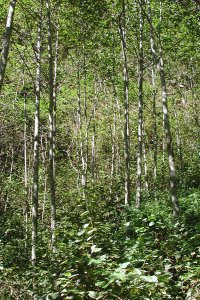
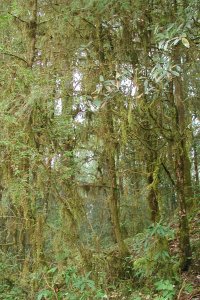
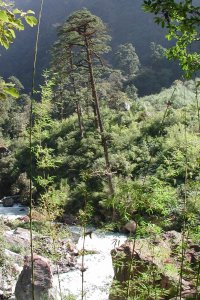
After Ghora Tabela (2950m) the valley is found to be dominated by large shrubs and bushy plants, probably due to human disturbance. This condition continues up to the snow line but on the left side of the valley the vegetation still persists and a regenerating Larch (Larix himalaica) forest is found to grow. This is also a site of special conservation for this species, a deciduous gymnosperm, within the Langtang National Park boundary.
We proceeded up to Kyanjin, via Langtang village, and collected plants around there. As mentioned earlier, on the left side of the Langtang river there is a good forest of Himalayan birch (Betula utilis) that forms a tree line around 4000m. The trunk and branches are thickly covered with hanging lichens (Usnea sp.). The understorey tree is Sorbus himalaica with white to pink berries. We came back by the same route up to Thulo Syabru (2210m ). On the way to Dhunche (2200m) the vegetation was found to be dominated by Pinus wallichiana of moderate growth condition and a small patch of Quercus lanuginosa associated frequently by Rhododendron arboreum, Rhus sp., Lyonia ovalifolia, Lithocarpus sp., etc. We came back to Kathmandu from Dhunche by bus.
For further pictures of the landscape and vegetation see the Expedition Diary